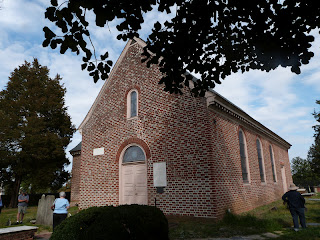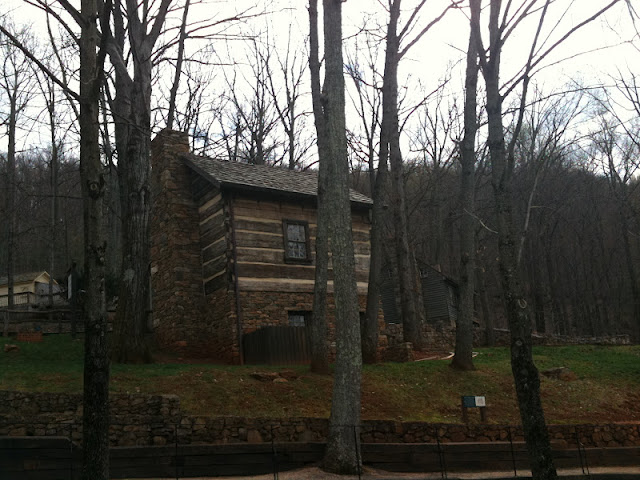Well, it's April, and that's when Lee surrendered to Grant in 1865, so John wants to go back to Appomattox. Besides, they just opened a branch of the Museum of the Confederacy, and John wants to be one of the first to visit. We have learned that, as meticulous as we are when we visit these places, we ALWAYS learn more the next time we visit - and the next - and the next. If nothing else, the tour guides are different and so get a different spiel.
So off we go to Appomattox. Then we'll spend the night in Richmond and drop down about 15 miles to Petersburg on Saturday. We have an appointment with the Centre Hill curator; she has given us permission to photograph a list of unique items we saw the first time we came!
We arrive by the stage road (well, almost) that runs from Lynchburg through Appomattox to Richmond.
We decide to by-pass the Visitor Center and start at the little bookstore where you get your National Parks passport stamped. (That's a fun little thing John started
years ago, and it's proven to have been a good idea. The stamp shows the date and location of your visit to all the different National Parks around the nation. The little book is getting a bit battered - but it is amazing to see how many years we've spent roaming around the country checking out it's history!) We're the only ones in the book store besides staff, and so we chat a bit and have fun. It's amazing the things one learns if one treats people as friends from the get-go. John gets a small something to remember the visit by, and we mosey outside.
The building next door was a tavern. Remembering how shocked Granny Beth was that we'd consider taking her to a tavern to eat, and not having been able to go inside this one the last time we were in Appomattox, we decide to check out the Clover Hill Tavern.
This is John being funny. He took this picture of me bending over taking a picture of the interpretive sign. He told a visitor standing next to him that he was going to show the picture to the kids and tell them I had just come out of the tavern and was throwing up! Tacky-tacky! And me actually
workin'! for the blog. Ah, well. At least he's having a good time...
Notice the words "Court House" and "courthouse." The first actually indicates a village or town; the second means a structure or building. If you'll remember our first blog post on Appomattox I explained that asking Lil' Miss GPS to give directions to Appomattox courthouse will take you to a different location - the
new courthouse a few miles from here. The spelling is what makes a difference.
So, anyway, back to the Clover Hill Tavern.
These are not the actual printing presses used by Grant's men to print up paroles for Confederate soldiers, but they are period pieces and are placed just as they might have been in 1865. Within a week almost 30,000 rebel troops had parole papers in hand and were headed home. In the room across the hall there are showcases with original documents:
Usually, when one army surrenders to another, they give up all that they have - and sometimes even themselves. Lincoln wanted to unite the nation - that was the bottom line with him.
Don't dissolve these United States!! He told Grant to give the most generous surrender terms probably ever given at a surrender. These "paroles" spelled out what the rebels could leave with. Some of the passes said "...Carriers and mounted men of the artillery and cavalry where horses are men's own private property will be allowed to retain them...." Also, "Besides allowing a Confederate soldier safe passage home, his parole could also be used to obtain free transportation on any Federal run railroad, packet boat, stage or wagon. Bringing his parole into any Federal installation on his way home, a soldier could also obtain rations."
Now, John read somewhere about a rebel from Texas
walking all the way back to Texas from Appomattox and very nearly starving to death before he got home. I suspect word didn't travel too quickly in 1865. If this soldier tried walking into a Federal installation, what guarantee was there that those Union troops had gotten the word of surrender? What guarantee was there that the reb wouldn't be shot dead on sight? Yeah, I think I would have walked and darn near starved before I'd go traipsin' into a Federal installation lookin' for a handout.
One of the National Park people that had been in the bookstore appears, and we continue our banter with him. He began showing us things that aren't normally shown on tours. Apparently the benches on the front porch had the unique feature of being able to switch the back rest from one side of the bench to the other. This nifty feature was so one wouldn't have to pick up the entire bench and turn it around just to sit and see in the opposite direction. Pretty cool.
Then, behind one of the benches he showed us a child's footprint in the slave-made brick of the tavern wall. Unfortunately there was no inscription to go with it, but its touching nonetheless. Elsewhere on the house (I'm not telling where :-), he unlatches a shutter and shows us what's hiding behind it:
It's a BAT! Look at those tiny back toes and knobby knees! She is apparently a permanent guest here at the tavern. Once, when she had babies, one of the babies dropped down onto the shoulder of a lady tourist. The ranger in attendance was sure all kinds of screaming was fixin' to take place, but, no. The lady just brushed it off her shoulder and never batted (no pun intended) an eyelash.
Yes, return trips to these places always seem to pay off in unexpected bonuses! Never fear, curators, WE will always return again and again! It is so very worth it!


























































